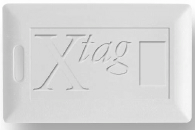July 8, 2003 – Xtag, an RFID tag and reader manufacturer based in Leeds, UK, has developed a new long-range access control system that uses active (battery-powered) RFID tags. The company says uses for its system include barrier control, vehicle tagging and hands-free access to parking garages, buildings, even operating rooms.
Xtag’s active tag operates at 433 MHz. It is similar to a credit card, except it is 7 mm thick and has a built-in battery that provides a read range of 80 feet (25 meters). The company says that when the tag transmits a signal every two seconds, the battery will last for more than four years.
Using active tags for access control is not new. Axcess, a Dallas, Texas, security systems company, introduced an access control system based on battery-powered tags in May (see New Active Tags for Access Control). The longer read range offered by active tags allows companies to tailor the system to their needs.
Xtag’s reader antennas, for instance, can be adjusted to limit the read range to as little as one and a half feet, or half a meter. A shorter read range might be used to control access to certain areas of a building, or to a parking garage, where readers at the entrance and exits could be placed within a few feet of where vehicle tags will pass. Longer read ranges might be used to control access to a truck yard.
Xtag plans to sell the system to original equipment manufacturers that want to expand the range of their own access control systems. The readers use industry-standard Wiegand output, so they can be hooked up to almost any networked access control system. That gives third parties the ability to integrate the active tag system with existing personnel or asset tracking.
Companies offering self-storage units could program the system to activate a burglar alarm automatically when no one is detected in the facility. As someone enters with an RFID badge, the alarm could be turned off. Xtag hopes its system will also appeal to fleet managers, who could attach the tags to their vehicles and issue ID tags to drivers. That way, the manager could identify both the driver and vehicle when entering or exiting a facility, or fueling the vehicles.
The company says its system is also useful in facilities with disabled persons or in hospitals. In one application, the active tags are put on wheelchairs, so that when a disabled person wants to enter a facility, a reader identifies him and the door opens automatically. Hospitals could use the system so doctors and nurses could gain hands-free access to operating rooms and other sterile areas.
A French private clinic that is currently interested in the Xtag product is looking to track a patient as the patient is assigned a hospital room, is moved to surgery and then returned to his room. The clinic wants to monitor the time it takes to move the patient throughout the facility. Xtag sells a special tag for tracking infants in hospitals (see Xtag Unveils Infant Security System).
Xtag says it can supply the RFID technology, which is available immediately, as a full solution through its nine distributors covering Europe, its technology partners (which include Link Technology), or as an OEM solution to access-control companies. Readers carry a list price of £299, and the tags sell for £22 each. — By Jennifer Maselli


